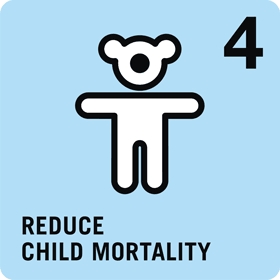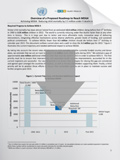2014
At Davos, MDG 4 Acceleration Roadmap Presented [Download Available]
by Ray Chambers
Key advocates for achieving the health-related MDGs presented a 700-day Achievement Roadmap to save the needed 2.2 million children’s lives to reach the global child health MDG by the December 31, 2015 deadline.

At an event at the World Economic Forum, key advocates for achieving the health-related Millennium Development Goals (MDGs) presented a 700 day Achievement Roadmap to save the needed 2.2 million children’s lives to reach the global child health MDG by the December 31, 2015 deadline.
This roadmap is in support of the UN Secretary-General’s Every Woman Every Child movement, which mobilizes and intensifies global action to improve the health of women and children around the world by working with leaders from governments, multilateral organizations, the private sector and civil society.
The proposed roadmap – spearheaded by a unique private-public partnership – is a bold expression of confidence that the health MDGs can be met.
“The world’s push to achieve the health-related MDGs is at a tipping point,” said UN Secretary-General Ban Ki-moon. “The Achievement Roadmap, in support of the Every Woman Every Child movement, shows that by saving one million additional lives, we can meet our goal of reducing child mortality. Let us do our utmost to make this progress possible — and let us build similar ambition into our work across the rest of the MDGs.”
The world is reducing under-five deaths faster than at any other time in history, in large part due to better and more affordable tools, innovative ways of delivering and integrating interventions, greater levels of funding, and sustained political commitment. Global child mortality has been almost halved from an estimated 12.6 million children dying before their fifth birthday in 1990 to 6.6 million children in 2012 according to UNICEF.
“To achieve MDG 4, fewer than 4.3 million children can die before their fifth birthday in 2015, down from approximately 6.6 million today,” said Ray Chambers, the UN Secretary General’s Special Envoy for Financing the Health MDGs and for Malaria. “Our collective goal is to reduce annual child deaths by 2.2 million by the end of 2015, which we believe is possible through currently funded plans plus the introduction of a set of smart, accelerative interventions.”
The Achievement Roadmap starts with estimates of the 1.2 million child lives on target to be saved through currently planned programs. But these efforts will leave an estimated gap of approximately one million additional children’s lives that must be saved in 2015 in order to achieve MDG 4. The Achievement Roadmap then proposes a set of feasible interventions with sizable potential impact and the ability to scale in a timely fashion. The list is neither exhaustive nor prescriptive, but represents a confident vision of how well-planned cooperation and coordination can take the ambitious child health goal across the 2015 finish line, and position the world for the next phase where we hope to eliminate all preventable child mortality. The greatest challenges will be at the local and sub-national levels, to integrate new efforts into existing systems and plans to achieve maximum additional impact.
The Achievement Roadmap is the result of months of planning by key implementing agencies and funding partners – including UNICEF, the United States Agency for International Development (USAID), the Government of Norway, the UN Commission on Life Saving Commodities, Clinton Health Access Initiative, and others. This plan follows the announcement in September 2013 of $1.15 billion for maternal and child health – by the World Bank, UNICEF, USAID and Norway, jointly with UN Special Envoy’s Office – providing not only additional resources necessary for life-saving interventions, but also tremendous momentum for the overall effort. These additional commitments, coupled with a highly encouraging start for the full $15-billion replenishment target for the Global Fund to Fight AIDS, TB and Malaria, a record $52 billion for the World Bank Group’s International Development Association (IDA), and what we hope will be a landmark replenishment of the Global Alliance for Vaccines and Immunization (GAVI), position country leaders, the global community of donors, and implementing organizations to finance the achievement of the health MDGs in 2015. We hope that these additional financing and technical assistance efforts will encourage national governments and their sub-national counterparts to work with the private sector and civil society to mobilize resources quickly and effectively.
Moreover, following the development of this roadmap to achieve the MDG on child mortality, plans are advancing with UNFPA, the Bill and Melinda Gates Foundation, Family Planning 2020, the UN Foundation, and others to develop complementary roadmaps for the achievement of the MDG targets on maternal mortality, as well as expansion of access to voluntary family planning information, services and supplies. Similar roadmaps, for instance, to achieve the target of finding and treating the 3 million “missing” TB cases are expected to follow.
Quotes:
USAID Administrator Dr. Rajiv Shah: “In an effort to deliver greater impact on a global scale, we are undertaking an intensive review of our global health portfolio in the 24 priority countries where more than 70 percent of under-five and maternal deaths occur annually. By aligning our resources more strategically, we can make evidence-based investments that that will accelerate development and, most importantly, save more lives.”
UNICEF Executive Director Anthony Lake: “MDG 4 is about children’s health, but it doesn’t mean that we can reach that goal only through health programmes. To achieve this goal, especially in the most deprived areas, we need to work on all the killers of children in an integrated way or we will not achieve MDG 4.”

Download a copy of the roadmap
About Every Woman Every Child:
Launched by UN Secretary-General Ban Ki-moon during the United Nations Millennium Development Goals Summit in September 2010, Every Woman Every Child aims to save the lives of 16 million women and children by 2015. It is an unprecedented global effort that mobilizes and intensifies international and national action by governments, multilaterals, the private sector, research and academia, and civil society to address the major health challenges facing women and children around the world. The effort puts into action the Global Strategy for Women’s and Children’s Health, which presents a roadmap on how to enhance financing, strengthen policy and improve service on the ground for the most vulnerable women and children.

